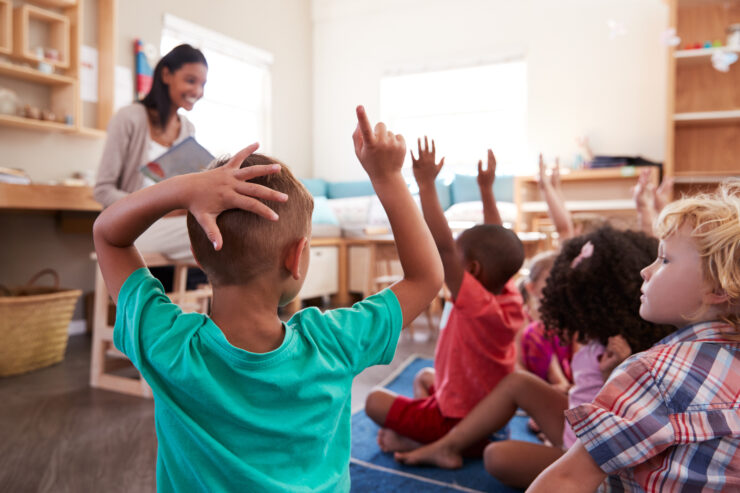How preschoolers see inequality in the classroom
Children think those who contribute more in class are more interested and intelligent

Sébastien Goudeau was inspired to research inequality in preschool for theoretical and personal reasons. Inequality starts early, and he wanted to understand, from the perspective of social psychology, what happens during the earliest stage of education. His children were very young as he began studying this topic, so he was particularly interested in how children interact with one another in preschool. Sébastien tells Annie Brookman-Byrne about his research into how preschoolers explain differences in the classroom.
Annie Brookman-Byrne: What have previous researchers learnt about inequality in preschool?
Sébastien Goudeau: From a theoretical perspective, it seems that how children are socialized in their families, which is influenced by social class, matters in the classroom. Social class can affect how children contribute to lessons, and also how they perceive themselves and other children – and I wanted to understand how that plays out in preschool.
“Social class can affect how children contribute to lessons, and also how they perceive themselves and other children.”
But this also had personal relevance for me. My two daughters were very young when I started researching inequality. Bringing them to playschool every day allowed me to spend some time there, and that contact made me think about interactions in the preschool environment. I was curious and wanted to learn more.
ABB: What did you discover in your recent research?
SG: My colleagues and I found that middle-class children are more likely to be called on by their teachers, they’re more likely to interrupt others, and they speak longer compared with working-class children. However, it’s not because they are more proficient than their working-class peers.
We also asked children how they explain differences in children’s contributions to class, using fictional children as examples. They were more likely to attribute these differences to differences in effort, interest, intelligence or other inherent characteristics than to family-related factors or teacher preferences.
After an initial study with around 100 children, we then replicated it with a larger sample and found similar results. This time, instead of asking the children about fictional children, we asked how they made sense of their actual experiences. For example, we asked them why they thought other children in the classroom were better or worse at math than they were. Again, children pointed to intrinsic factors like intelligence more than to external factors.
ABB: What effects do these perceptions have on children?
SG: The children who are more likely to experience difficulty and less likely to contribute also perceive themselves as lacking ability, investing too little effort, and lacking interest. This can amplify the inequality that was already there at the start. Structural inequality impacts what happens in the classroom, and the psychological side amplifies that. To address this inequality, we need changes in policies, programs, and teacher training.
“Structural inequality impacts what happens in the classroom, and the psychological side amplifies that.”
When we asked the same questions of teachers, we found exactly the same pattern. Teachers perceive children who contribute more to be more intelligent, thoughtful, and interested, while they see children who contribute less in the classroom as lacking in ability, interest, and motivation. It’s important for teachers to understand the structural inequality that causes children from different backgrounds to contribute differently. Children’s perceptions may be influenced by what their teachers think, as communicated in the feedback teachers provide.
ABB: Have you learnt anything from this research that you apply to your personal life?
SG: In both my personal and my professional life, I try to be mindful of how I perceive those around me. I also try to make others aware of the external constraints that can affect people’s behaviours. In addition, I avoid focusing on ability or interest when providing feedback to my children and my students.
As a parent, I find it hard to keep from constantly telling my daughters how smart, nice, and kind they are. Positive feedback can be good for children’s self-esteem, and this is especially important when they encounter difficulties. Yet there is also such a thing as too much praise – you don’t want your children to become narcissists. It can be better to praise children for their effort rather than for their ability. However, we have more to learn about the best ways to provide feedback in a manner that increases self-esteem and builds confidence, without perpetuating a bias toward seeing people’s achievements in terms of their inherent characteristics.
Footnotes
Sébastien Goudeau was a primary school teacher for six years before joining the faculty of the University of Poitiers as an associate professor of social psychology. He conducts his research on schools, from kindergarten to university, at the Center for Research on Cognition and Learning. He teaches at INSPE (Institut national supérieur du professorat et de l’éducation/ National Higher Institute of Teaching and Education), where he trains future teachers. Sébastien is a Jacobs Foundation Research Fellow 2023-2025.
Sébastien on X, LinkedIn, and ResearchGate
Sébastien’s lab
Sébastien Goudeau contributed to a special collection on understanding and addressing inequality in education in the journal npj Science of Learning. This interview is part of a series dedicated to sharing practical takeaways and personal insights from authors.
The interview has been edited for clarity.


